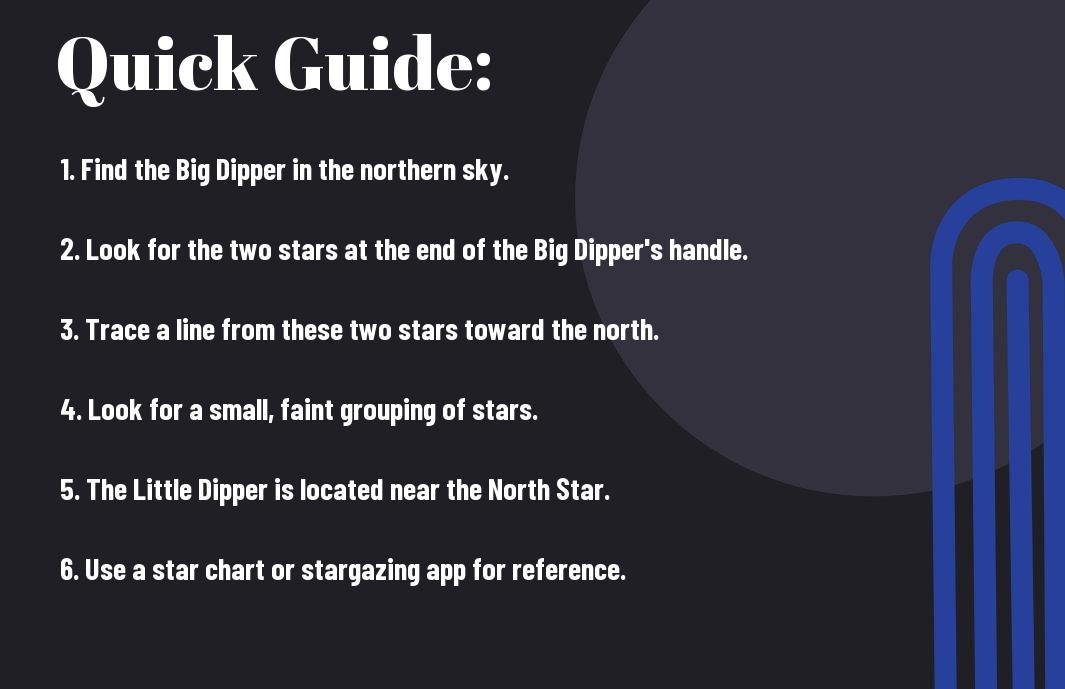As an avid stargazer, I have always found the Little Dipper constellation to be an enchanting sight in the night sky. The Little Dipper is known for its distinctive shape and can be a rewarding constellation to locate, especially for amateur astronomers. In this guide, I will share with you some tips and tricks on how to find the Little Dipper in the night sky, including the best times and locations to view it, as well as some interesting facts about this captivating celestial phenomenon. So, grab your telescope and let’s get ready to embark on a cosmic journey to locate the Little Dipper.
Key Takeaways:
- Look for the North Star: The Little Dipper can be found by locating the North Star, also known as Polaris, which is the last star in the handle of the Little Dipper.
- Find the Big Dipper first: The Big Dipper is a useful tool for locating the Little Dipper, as the two constellations are always found together in the night sky. The two outer stars of the Big Dipper point directly to the North Star.
- Use the “arc to Arcturus” method: By following the curve of the handle of the Big Dipper and extending it towards the bright orange star Arcturus, you can find the North Star and then the Little Dipper.
- Seek out a dark, clear night: To locate the Little Dipper, it is important to find a dark area away from city lights, as light pollution can make it difficult to see the stars.
- Consider using stargazing apps: Utilize stargazing apps or websites to help locate the Little Dipper and other constellations in the night sky, as they can provide real-time information and maps to assist with navigation.
Locating the Little Dipper Constellation
Before you can start your search for the Little Dipper constellation, it’s important to have a basic understanding of how to locate it in the night sky. The Little Dipper is a circumpolar constellation, meaning it is visible year-round in the northern hemisphere. It is located within the Ursa Minor constellation, and contains the North Star, Polaris, at its tip. In order to find the Little Dipper, you first need to identify Polaris, then look for the distinct shape of the dipper’s handle and cup.
Types of Little Dipper Constellation Maps
When it comes to finding the Little Dipper in the night sky, there are several types of maps that can be used to assist in the search. Some of the most common maps include interactive online maps, star charts, and smartphone apps. These maps can help you identify constellations and locate specific stars and planets in the night sky. This helps to assist in finding the Little Dipper and other celestial bodies. This information can be summarized into a table for easy reference.
Tips for Finding the Little Dipper in the Night Sky
When searching for the Little Dipper, there are a few tips that can help make the process easier. One tip is to find a location away from light pollution, which can obstruct the view of stars and constellations. Additionally, using a star chart or smartphone app can help you identify the specific location of the Little Dipper in relation to other celestial bodies. Knowing how to use these tools effectively can greatly improve your chances of success.
Step-by-Step Guide to Locating the Little Dipper
If you’re struggling to locate the Little Dipper, it can be helpful to follow a step-by-step guide. First, find the North Star Polaris, then look for the distinctive shape of the Little Dipper’s handle and cup. This can be easier with the assistance of a star chart or smartphone app, which can help you identify the specific location of the Little Dipper in relation to other celestial bodies. This information can be summarized into a table for easy reference.
Factors Affecting Visibility of the Little Dipper
Any factors that affect the clarity and visibility of the night sky can impact your ability to see the Little Dipper. These factors can include light pollution, weather conditions, and the presence of obstructions such as tall buildings or trees. It’s important to consider these factors when planning your stargazing excursion.
Pros and Cons of Using Different Methods to Find the Little Dipper
When attempting to locate the Little Dipper, there are various methods that can be employed. Each method comes with its own set of pros and cons, which should be carefully considered. For example, using a smartphone app may provide real-time guidance, but it can also be affected by battery life and signal strength. On the other hand, a star chart may have a wider field of view, but it can be more challenging to use in the dark. This information can be summarized into a table for easy reference.

Conclusion
Drawing together the knowledge and tips provided in this guide, I am confident that you will be able to find the Little Dipper constellation in the night sky. By locating the North Star and using the two outer stars of the Big Dipper, you can easily trace your way to the Little Dipper. Remember to find a dark location with minimal light pollution for the best viewing experience. With a little practice and patience, you will soon be able to identify this iconic constellation with ease.
FAQ
Q: What is the Little Dipper constellation?
A: The Little Dipper is a well-known group of stars that form a part of the Ursa Minor constellation. It is called the Little Dipper because its shape resembles a ladle or a small dipper. It is best known for containing the North Star, which makes it an important navigational tool.
Q: When is the best time to see the Little Dipper?
A: The Little Dipper can be seen throughout the year in the northern hemisphere. The best time to view it is during the spring and summer months when it is high in the sky and visible for longer periods of time.
Q: How do I locate the Little Dipper in the night sky?
A: To locate the Little Dipper, first find the Big Dipper, which is easier to spot. The two outer stars of the Big Dipper’s bowl point towards the North Star. The North Star is the last star in the handle of the Little Dipper, so once you locate the Big Dipper, follow the line formed by these two outer stars to find the North Star and the Little Dipper.
Q: Can I see the Little Dipper from anywhere in the world?
A: The Little Dipper is visible from most northern latitudes, but it may not be visible in its entirety from locations near the equator or in the southern hemisphere. The further north you are, the higher it will appear in the sky, making it easier to see.
Q: What are some tips for better viewing of the Little Dipper?
A: If you are having difficulty spotting the Little Dipper, try to find a location with minimal light pollution. Additionally, using a star chart or a stargazing app can be helpful in identifying the position of the constellation in the night sky. It is also recommended to give your eyes time to adjust to the darkness to better see the stars.









